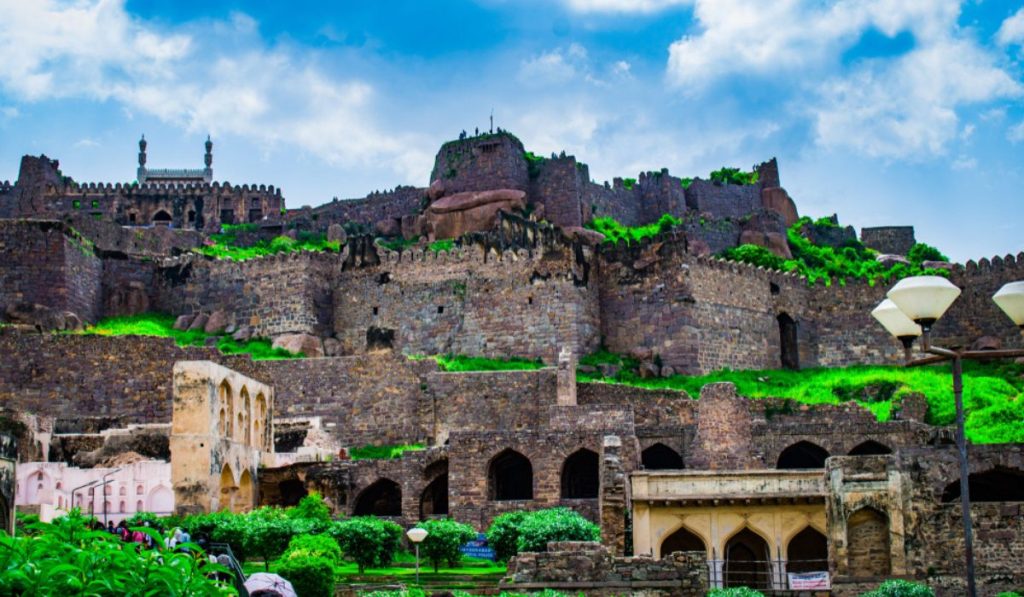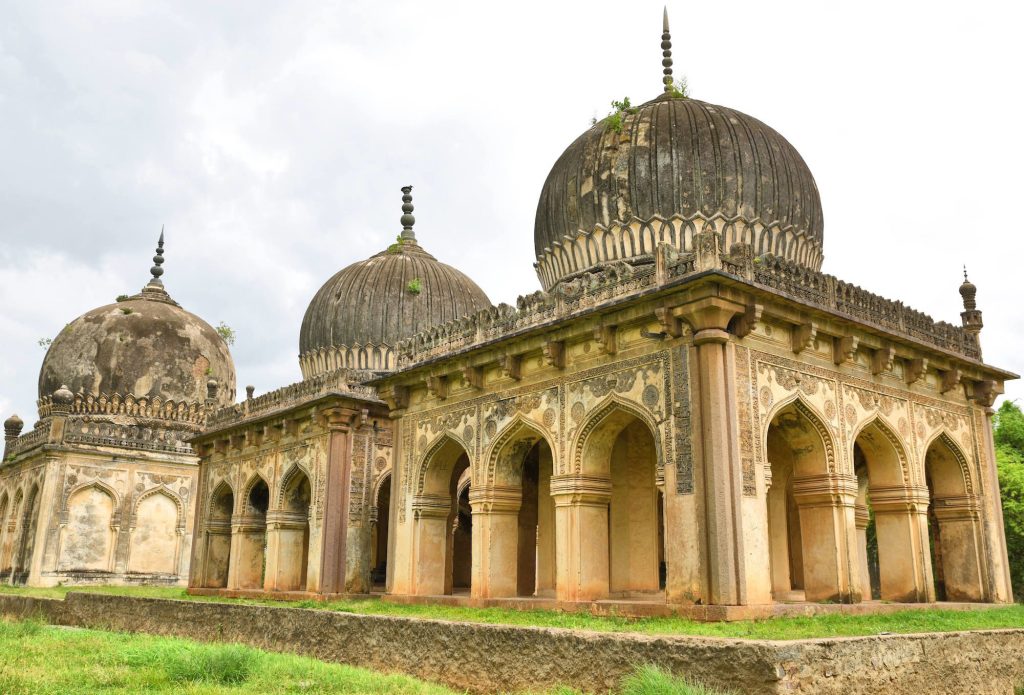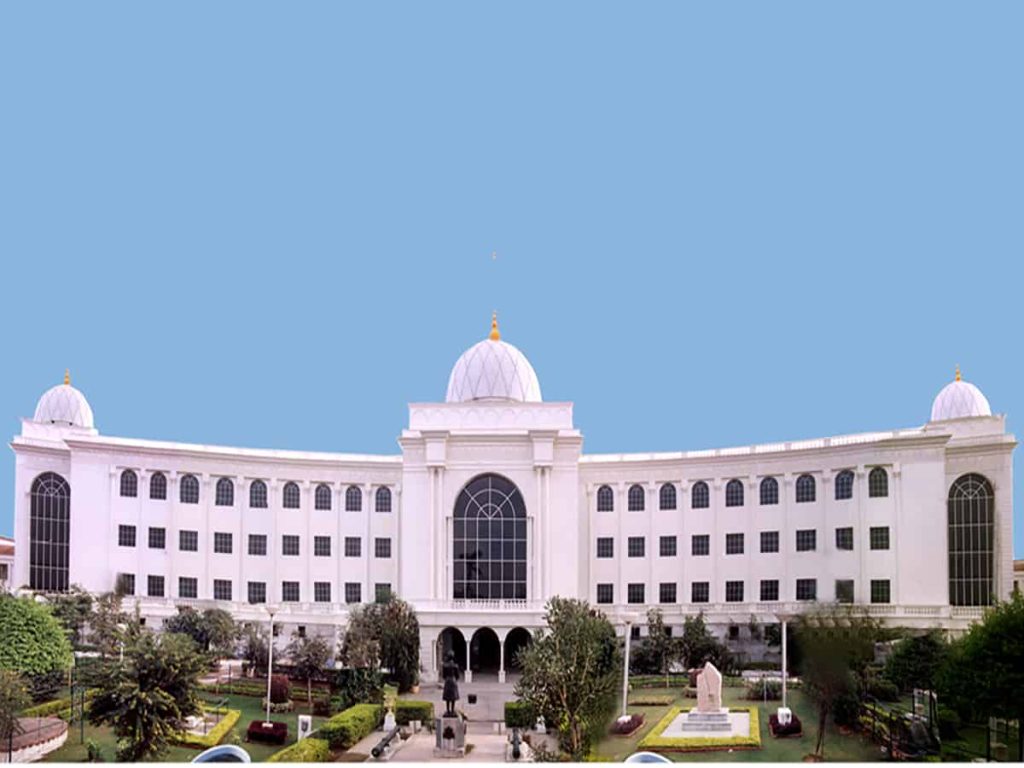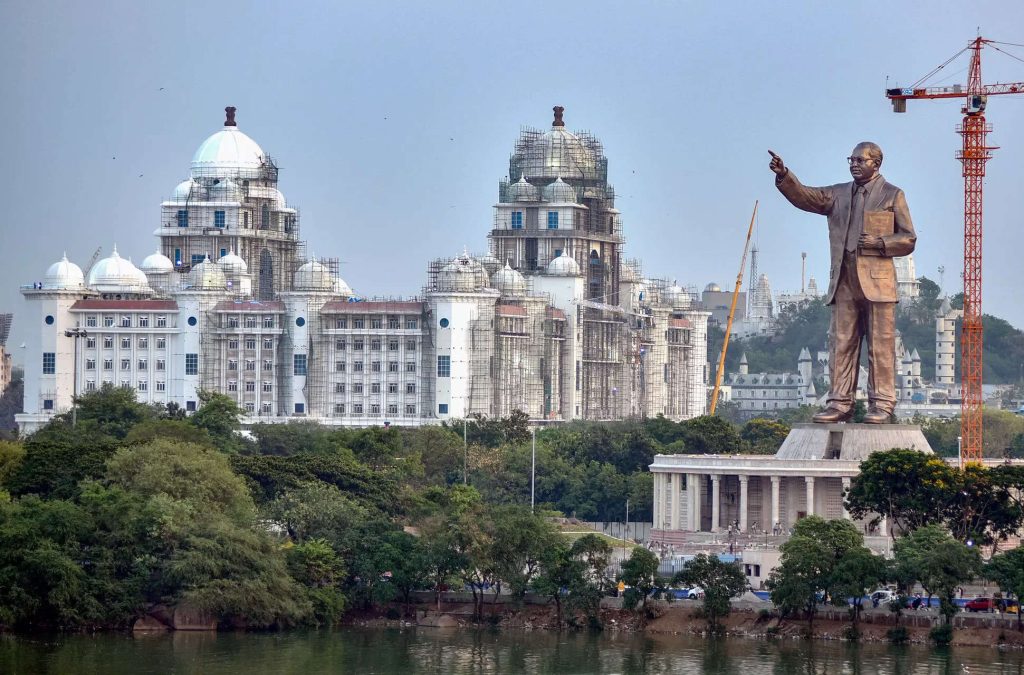Destination

Golconda fort
Golconda was the principal capital of the Qutub Shahi kings. The inner fort contains ruins of palaces, mosques and a hill top pavilion, which rises about 130 meters high and gives a bird’s eye view of other buildings. Golconda fort is undoubtedly one of most magnificent fortress complexes in India.

Qutub Shahi tombs

Charminar
Charminar was built by Sultan Mohammed Quli Qutb Shah in 1591. It is said that this square shaped structure with four pillars and intricate carvings was built in honour of his wife, Bhagmati. However, the actual reason behind building Charminar is still not clear.
As per a popular belief, Charminar was built to acknowledge the elimination of the plague which had affected the entire city immensely during that era. It is believed that the Sultan had prayed for the end of this plague with which his people were suffering. Hence, as the plague ended, he built the charminar as a tribute to Allah. The four pillars are also said to be dedicated to the first four caliphs of Islam.

Mecca Masjid
Built with local granite, it finds place among largest mosques in India and is the most important and largest one in the city. The arched gallery displays the tombs of all the Nizam’s from the year 1803. The mosque has a length of 225 feet and is 180 feet wide with a height of 75 feet. The name is derived from the Grand Mosque in Mecca on which it is modeled. The hall has a dimension of 67 metres x 54 metres x 23 metres. The roof is rested on 15 arches.
There is a high blocking wall on the western side for Mehrab. It has two huge octagonal columns, which are created from a single piece of granite. This is inturn topped by an arched gallery crowned by a dome. This mosque can accommodate 10,000 worshipers at any time. It is located two hundred yards from Charminar. The mosque was believed to have used bricks during its construction where brought from Mecca. A room in the courtyard is believed to house a sacred relic of the prophet.

Salar Jung Museum
Situated on the southern banks of Musi River, the Salarjung Museum has a unique distinction as the third largest museum in India and has a worldwide fame for its biggest one-man collections of antiques. It is widely known in India for its prized collections dating back to different civilizations. Nawab Mir Yousuf Ali Khan Salar Jung III, the former Prime Minister of the 7th Nizam of Hyderabad, spent most of his income over a period of thirty-five years to gather such priceless collections, which according to historians was his intense passion.
The collections that was left behind in his ancestral Diwan Deodi palace were exhibited earlier as a private museum that was inaugurated by the then PM of India Jawaharlal Nehru in 1951. Later in the year 1968, the museum was shifted to its current location at Afzalgunj. The renowned museum is now administered by a Board of Trustees which also includes Governor of Telangana as an ex-officio chairperson as per the Salar Jung Museum Act of 1961.

Purani Haveli
Purani Haveli is an integral part of the heritage and ethos of the city of Hyderabad is Displaying some of the most exquisite forms of craftsmanship, Purani Haveli was a palace was originally built to serve as the home to the Peshwa of Mohammed Quli Qutub Shah, Mir Momen. Today, Purani Haveli is undeniably one of the significant parts of Hyderabad’s golden era and is known for its remarkable exhibits of artwork and talent and functions as a museum. It is a beautiful structure comprising great treats for history lovers! One of the most unique features of the Purani Haveli is a wardrobe, which is the longest in the world! It is built on two levels and has a hand-operated elevator in place. Many building of this vast complex currently serve as educational institutions.

Chowmala palace
The history of Hyderabad is so enticing that it feels like reading a wonderful love story and its glorious past is no less than a fairy tale. And the most interesting part of this novel forms the rule of the Nizams, which fills pages of history with legendary contributions of art, architecture and science.
A testimony to this aspect is seen in the form of the many exquisite monuments scattered all over the city. One such monument that in its striking sumptuousness still shows off the power of time immemorial is the engrossing Chowmahalla Palace. The name Chowmahalla refers to four palaces. The construction of the palace was initiated in the year 1750 by Nizam Salabhat Jung but it was Nizam Afzar-ud-Dawla Bahadur who saw that the palace was completed between the years 1857 and 1869. Originally, the palace covered 45 acres from Laad Bazaar on the north to Aspan Chowk Road which is on the south. The Chowmohalla complex is a replica of Shah’s Palace in Teheran, Iran. Presently the palace consists of two courtyards with graceful palaces, the grand Durbar Hall or the Khilwat. Gardens and fountains add to the elegance

Birla Mandir
The Birla Mandir in Hyderabad forms a pleasant serene atmosphere and is a perfect place for those who wish to get away from city life and immerse themselves in prayer and meditation. The Mandir is dedicated to the Lord Venkateshwara of Tirumala and is in fact modelled after and is the replica of the idol of Balaji of Tirupati.
Created in 1976 by Swami Renganathananda from Ramakrishna Ashram and constructed by the Birla Foundation, the Birla Mandir has been a safe haven for all those looking for a few hours of peace amongst the glorious landscape. The temple itself is located at the top of a 280 feet tall hill called the Naubat Pahad that overlooks both, Hyderabad and Secunderabad as well as the Hussain Sagar Lake and is one of the best viewpoints in the city.

Ambedkar Statue
The imposing building of the Secretariat, the nerve centre of the state’s administration, has come up near the picturesque Hussain Sagar lake in the heart of the city.
Chief Minister K. Chandrasekhar Rao will inaugurate the complex named after chief architect of the Indian Constitution B. R. Ambedkar.
The stunningly beautiful photographs of the new complex, including its breathtaking interiors, have gone viral on social media.
Chief Minister KCR’s daughter and legislator K. Kavitha on Sunday shared some pictures of the building including the main entrance, opulent corridors and dazzling meeting halls.
“On April 30, our State will have a new state of art structure & the upcoming centre stage of the state’s progress – Dr. B. R. Ambedkar Telangana Secretariat. It is the vision of CM KCR Garu to make progress, development & growth synonymous to the very being of Telangana & our people,” wrote Kavitha, a member of the Telangana Legislative Council.

Ramoji Film City
Home to the world’s largest film studio complex according to the Guinness Book of World Records, the magical and magnificent Ramoji Film City has developed into a neighbourhood with its own unique charm that attracts millions of tourists who drive 34 km outskirts of Hyderabad to watch Tollywood movie sets and film actors at work. Spread over 1500 acres, this massive film city is dotted with vast gardens, large kitschy statues, replicas of popular historical monuments, open-air film sets, multi-cuisine restaurants, fast food joints and stylish cafes. You can spend an entire day here and choose to stay back in the 5-star and 7-star hotels in the film city. Head to the hilltop from where you can get spectacular views of the entire film city. On your way back, drive through the nearby Pochampally, a cluster of villages that is famous for its Ikat style of weaving for some traditional Hyderabad handloom shopping.

Hussain Sagar lake
Situated just 2km away from the heart of the city, Hussain Sagar is one of the most popular tourist places in Hyderabad. The lake connects two parts of the city (Secunderabad and Hyderabad) to each other. The largest artificial lake in Asia, Hussain Sagar lake was excavated in 1562 AD during the reign of Ibrahim Quli Qutub Shah. Built on the tributary of River Musi, the lake has been named after Hussain Shah Wali. Hussain Sagar Lake was initially to build to cater to the irrigation needs and other water needs of the city. Until the year of 1930, it was used for the same purpose.
Having been bordered by Indira Park in the east, Sanjeevaiah Park in the north and Lumbini Park in the south, the lake presents a setting quite rare to find in the middle of any city. There is also a bund on its banks, which was built to control the flow of water. This artificial lake now beautifies the city gracefully. Not just for beauty, it is also known for its historical connection. On the banks of this Hussain Sagar Lake the treaty between Mughals and Golconda was signed.
